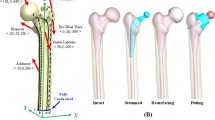Abstract
Background
Stress shielding and nonphysiological load transfer after primary or revision total hip replacement (THR) prepare the ground for resorptive bone remodeling. The quality of the bone stock influences the risk of periprosthetic fractures and the severity of future revision surgeries. The question of whether or not bending stiffness and distal screw interlocking influence load transfer of a modular revision hip stem with a solid, hollow, and hollow-slotted stem extension led to the conception of this experimental study. The results were compared with a standard hip stem for primary THR.
Methods
Revision stems were implanted in photoelastically coated composite femora. Cortical strain mapping was conducted before and after insertion of the implants under standardized loading conditions, considering the relevant muscle forces. Statistical analysis was based on a 95% confidence interval and a variance analysis for repeated measurements.
Results
Significant stress shielding was observed after insertion of all types of hip stems compared with the intact femora. There was also a marked difference between strain alterations induced by standard and revision hip stems. With revision stems, the most distinct stress shielding effects were registered with the solid stem extension, particularly in the femoral diaphysis. Distal interlocking screws only had a local action on strain pattern and tended to enhance stress shielding at the midstem area when using the more flexible components.
Conclusion
More flexible revision stems provide a cortical strain pattern of the femur closer to the preoperative status. This may reduce resorptive bone remodeling in the long term. However, any type of revision stem tested in this study caused higher stress shielding than the hip stem for primary THR, especially in the diaphyseal region medially and laterally. With sufficient proximal anchorage, the influence of distal interlocking screws on the femoral strain pattern was localized.





Similar content being viewed by others
References
Garellick G, Kärrholm J, Rogmark C, Herberts P. Swedish National Hip Arthroplasty Register (October 2009): Annual Report 2008. Swedish National Hip Arthroplasty Register. Department of Orthopaedics, Sahlgrenska University Hospital, SE-413 45 Göteborg. http://www.jru.orthop.gu.se.
Bobyn JD, Glassman AH, Goto H, Krygier JJ, Miller JE, Brooks CE. The effect of stem stiffness on femoral bone resorption after canine porous-coated total hip arthroplasty. Clin Orthop Relat Res. 1990;261:196–213.
Cristofolini L. A critical analysis of stress shielding evaluation of hip prostheses. Crit Rev Biomed Eng. 1997;25:409–83.
Engh CA, O′Connor D, Jasty M, McGovern TF, Bobyn JD, Harris WH. Quantification of implant micromotion, strain shielding and bone resorption with porous-coated anatomic medullary locking femoral prostheses. Clin Orthop Relat Res. 1992;285:13–29.
Hua J, Walker PS. A comparison of cortical strains after cemented and press-fit proximal and distal femoral replacement. J Orthop Res. 1992;10:739–44.
Huiskes R, Weinans H, van Rietbergen B. The relationship between stress shielding and bone resorption around total hip stems and the effects of flexible materials. Clin Orthop Relat Res. 1992;274:124–34.
Engh CA, Hooten JP, Zettl-Schaffer KF, Ghaffarpour M, McGovern TF, Bobyn JD. Evaluation of bone ingrowth in proximally and extensively porous-coated anatomic medullary locking prostheses retrieved at autopsy. J Bone Joint Surg Am. 1995;77:903–10.
Sumner DR, Galante JO. Determinants of stress shielding: design versus materials versus interface. Clin Orthop Relat Res. 1992;274:202–12.
Richards CJ, Duncan CP, Masri BA, Garbuz DS. Femoral revision hip arthroplasty: a comparison of two stem designs. Clin Orthop Relat Res. 2010;468:491–6.
Iwana D, Nishii T, Miki H, Sugano N, Sakai T, Ohzono K, Yoshikawa H. Proximal bone remodelling differed between two types of titanium long femoral components after cementless revision arthroplasty. Int Orthop. 2008;32:431–6.
Kärrholm J, Razaznejad R. Fixation and bone remodeling around a low stiffness stem in revision surgery. Clin Orthop Relat Res. 2008;466:380–8.
Hansen M, Degreif J, Runkel M, Vogel N, Rommens PM. Die Versorgung von Femurfrakturen bei Hüftendoprothese. Erste Ergebnisse mit einem elastisch stielverlängerten Prothesenschaft. Unfallchirurgie. 1998;24:154–61 (in German).
Wenzl HR. Die Verriegelungsprothese. Z Allg Med. 1998;74:190–1 (in German).
Bergmann G, Deuretzbacher G, Heller M, Graichen F, Rohlmann A, Strauss J, Duda GN. Hip contact forces and gait patterns from routine activities. J Biomech. 2001;34:921–6.
Brand RA, Pedersen DR, Davy DT, Kotzar GM, Heiple KG, Goldberg VM. Comparison of hip force calculations and measurements in the same patient. J Arthroplasty. 1994;9:45–51.
Stansfield BW, Nicol AC, Paul JP, Kelly IG, Graichen F, Bergmann G. Direct comparison of calculated hip joint contact forces with those measured using instrumented implants. An evaluation of a three-dimensional mathematical model of the lower limb. J Biomech. 2003;36:929–36.
Duda GN, Heller M, Albinger J, Schulz O, Schneider E, Claes L. Influence of muscle forces on femoral strain distribution. J Biomech. 1998;31:841–6.
Cristofolini L, Viceconti M, Toni A, Giunti A. Influence of thigh muscles on the axial strains in a proximal femur during early stance in gait. J Biomech. 1995;28:617–24.
Doria C, De Santis V, Falcone G, Proietti L, De Santis E. Osseointegration in hip prostheses: experimental study in sheep. Int Orthop. 2003;27:272–7.
Gibbons CER, Davies AJ, Amis AA, Olearnik H, Parker BC, Scott JE. Periprosthetic bone mineral density changes with femoral components of differing design philosophy. Int Orthop. 2001;25:89–92.
Heiner AD, Brown TD. Structural properties of a new design of composite replicate femurs and tibias. J Biomech. 2001;34:773–81.
Steinhauser E, Ellenrieder M, Gruber G, Busch R, Gradinger R, Mittelmeier W. Influence on load transfer of different femoral neck endoprostheses. Z Orthop Ihre Grenzgeb. 2006;144:386–93 (in German).
Birnbaum K, Siebert CH, Pandorf T, Schopphoff E, Prescher A, Niethard FU. Anatomical and biomechanical investigations of the iliotibial tract. Surg Radiol Anat. 2004;26:433–46.
Zhou XM, Walker PS, Robertson DD. Effect of press-fit femoral stems on strains in the femur. A photoelastic coating study. J Arthroplasty. 1990;5:71–82.
Vail TP, Glisson RR, Koukoubis TD, Guilak F. The effect of hip stem material modulus on surface strain in human femora. J Biomech. 1998;31:619–28.
Emerson RH. Proximal ingrowth components. Clin Orthop Relat Res. 2004;420:130–4.
Incavo SJ, Johnson CC, Churchill DL, Beynnon BD. Bending stiffness, torsional stability, and insertion force of cementless femoral stems. Am J Orthop (Belle Mead NJ). 2001;30:323–7.
Hansen M, Blum J, Mehler D, Hessmann MH, Rommens PM. Double or triple interlocking when nailing proximal tibial fractures? A biomechanical investigation. Arch Orthop Trauma Surg. 2009;129:1715–9.
Hardy DCR, Drossos K. Slotted intramedullary hip screw nails reduce proximal mechanical unloading. Clin Orthop Relat Res. 2003;406:176–84.
Eingartner C, Volkmann R, Winter E, Weise K, Weller S. A long straight stem with distal interlocking for uncemented stem revision in THR. Surg Technol Int. 2000;IX:273–9.
Acknowledgments
We thank Mrs. Raymonde Busch Dipl.-Math. (Institut für Medizinische Statistik und Epidemiologie, Technische Universität München) for her assistance in statistical analyses.
Conflict of interest
All authors disclose any commercial affiliations as well as consultancies, stock ownership or patent-licensing arrangements that could be considered to pose a conflict of interest regarding the submitted article.
Author information
Authors and Affiliations
Corresponding author
About this article
Cite this article
Ellenrieder, M., Steinhauser, E., Bader, R. et al. How stiffness and distal interlocking of revision hip stems influence the femoral cortical strain pattern. J Orthop Sci 17, 205–212 (2012). https://doi.org/10.1007/s00776-012-0201-4
Received:
Accepted:
Published:
Issue Date:
DOI: https://doi.org/10.1007/s00776-012-0201-4




